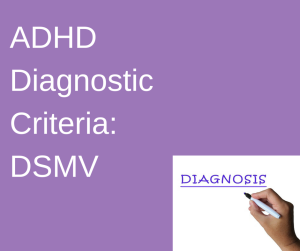 The DSMV, the Diagnostic and Statistical Manual of Mental Disorders, guideline for all psychiatric disorders, was updated in 2013 by the American Psychiatric Association. The following are the updated criteria for an evaluation for ADHD.
The DSMV, the Diagnostic and Statistical Manual of Mental Disorders, guideline for all psychiatric disorders, was updated in 2013 by the American Psychiatric Association. The following are the updated criteria for an evaluation for ADHD.
9 Inattention Symptoms (Six or more symptoms present for 6 months or more)
- Consistently disorganized
- Problems organizing activities
- Cannot focus or pay attention to tasks or instruction
- Forgetful
- Frequently loses personal items (arrives at class unprepared, loses toys and tools)
- Begins tasks or assignments, but frequently does not follow through and leaves them uncompleted
- Appears not to listen, even when directly addressed
- Makes careless mistakes in school work, professional work, and other activities
- Avoids taking on tasks that require sustained mental effort for long periods
9 Hyperactivity-impulsivity Symptoms (Six or more symptoms present for 6 months or more) Note: For individuals 17 and above, only 5 or more symptoms are needed because overtly hyperactive symptoms reduce with age.
- Talks excessively at home, in class, at work, and other places
- Has difficulty remaining seated in situations where sitting still is expected
- Children may move about a room, climb, or run where inappropriate to do so – teens and adults feel restless
- Cannot sit still when seated and frequently squirms, fidgets, or moves around
- Difficulty playing quietly (children) or quietly engaging in leisure activities (teens and adults)
- Seems constantly moving and driven, as if by a motor
- Impatient and has trouble waiting his or her turn
- Interrupts others’ conversations or games
- Blurts out answers to questions before the speaker has completed the question
If you or your child exhibits six or more of the symptoms on either or both of these lists, you should consider having a professional evaluation for ADHD.
Making the Diagnosis
- Note: To make a diagnosis of ADHD, these symptoms should not be better explained by another physical or mental disorder. Dysfunction or upheaval in the home, school or work environment can also cause similar symptoms and should be considered.
- To be diagnosed with the disorder, a child must have symptoms for 6 or more months and to a degree that is greater than other children of the same age. For adults, symptoms must have been evident in some way by their teen years.
- Symptoms appear, on average, between 3 and 6 years of age. And a diagnosis requires that some symptoms were evident before the age of 13 years.
- There are three categories or “presentations” of ADHD; ADHD with Hyperactivity, ADHD/Inattentive type, or ADHD/Combined type. Dr. Daniel Amen proposed even more types. For more information, see Recognizing the Types of ADHD on Everyday Health.
Don’t expect a quick diagnosis
“According to developmental pediatrician, Mark Bertin,
“An initial evaluation includes a detailed history along with physical and neurological examinations. These appointments explore psychological, family and educational factors that may be triggering concerns. Developmental tests are used to observe your child’s cognitive, language, motor, and academic abilities, or specific aspects of behavior.” (1)
“An evaluation should also identify strengths as well as the likely causes of any difficulties.
The goal is to create as comprehensive picture as possible of skills and to provide practical information for planning accommodations.” (1)
Unfortunately, primary care pediatricians are failing to meet the standards of care set forth by the American Pediatric Association on many levels. (See results of a 2014 study reported by David Rabiner in “Pediatric care for children with ADHD – Discouraging new findings.”) Your doctor is doing you a disservice if all he provides is a 15 minute visit followed by a prescription and maintains that is sufficient for the diagnosis and treatment of ADHD.
Serious impairment
“Inattention, hyperactivity, and impulsivity are the key behaviors of ADHD,” states Russell Barkley, PhD. “ It is normal for all children to be inattentive, hyperactive, or impulsive sometimes, but for children with ADHD, these behaviors are more severe and occur more often. ”(2) It’s important to keep in mind that not every high-energy or impulsive child has ADHD. Children and adults are diagnosed with ADHD only if they demonstrate these symptoms so often that they are causing real difficulty. Impairment in two areas of life, playground, classroom, home, social, or the workplace, is crucial.
Developmental delays in Executive Function and control of emotions are also problematic. (2, 3) The inability to regulate attention stalls building self-regulation, or self-control, a mark of growth and maturity. These will show up in everyday situations as chronic disorganization, memory problems, procrastination, a lack of motivation or follow through in situations when interest or the pressure of deadlines isn’t high. Frustration is a common response and invites overwhelm and anger at the situation as well as at themselves.
Take ADHD seriously!
There’s still a lot of misunderstanding and moral judgment that those with ADHD are PURPOSEFULLY not living up to expectations. The extent of these difficulties permeates how those with ADHD think of themselves, as “less than” others. According to a 2006 study, “Children with a history of ADHD were 6 times as likely as those without ADHD to have a high level of overall difficulties including emotional, conduct, and peer problems and were 9 times as likely to manifest a high level of impairment including interference with home life, friendships, classroom learning, and leisure activities.”(4) Early diagnosis and effective treatment, preferably combining medications and behavior changes for parent, child, and adults, is the key to building self-awareness and skills that can change many of the negative outcomes.
Note: Basic symptoms checklist is taken from “New Diagnostic Criteria for ADHD: Subtle but Important Changes” by Ravid Rabiner, Ph.D.
1) Evaluation Process from Developmental Pediatrician, Mark Bertin, MD. – author of The Family ADHD Solution: A Scientific Approach to Maximizing Your Child’s Attention and Minimizing Parental Stress From ADHD: Does my Child Have it? https://breezymama.com/2011/04/11/adhd/#more-15443 Harvested January 29, 2021
2) Russell Barkley’s ADHD Fact sheet – http://www.russellbarkley.org/factsheets/adhd-facts.pdf Harvested 2/28/2016
3) The validity of the executive function theory of attention-deficit/hyperactivity disorder: a meta-analytic review. Willcutt, EG, Doyle, AE, Nigg, JT, et al. http://www.ncbi.nlm.nih.gov/pubmed/15950006 Harvested 10/22/2014
4) Emotional and Behavioral Difficulties with Impairments in Everyday Functioning among Children with a history of Attention-Deficit/Hyperactivity Disorder – Tara W. Strine, MPH, Catherine A Lesenesne, PhD, Catherine A Okoro, MS, et al. http://www.cdc.gov/pcd/issues/2006/apr/05_0171.htm Harvested March 2, 2015
“Image courtesy of Stuart Miles/FreeDigitalPhoto.net” Modified on Canva.com

